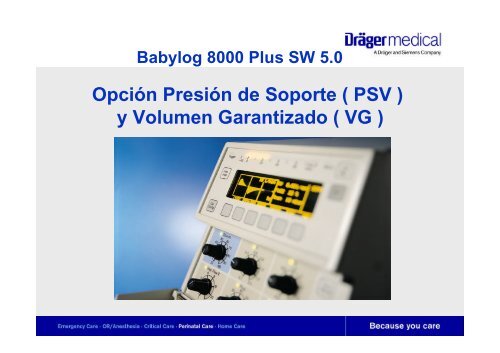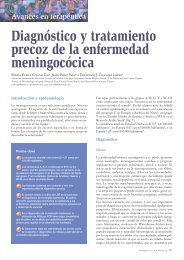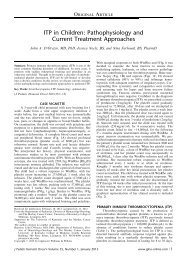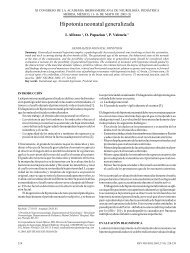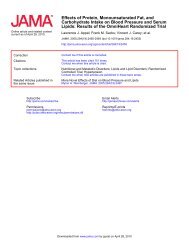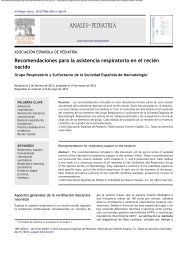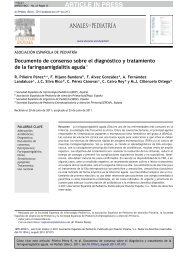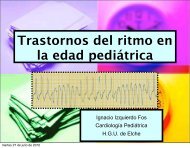Opción Presión de Soporte ( PSV ) y Volumen Garantizado ( VG )
Opción Presión de Soporte ( PSV ) y Volumen Garantizado ( VG )
Opción Presión de Soporte ( PSV ) y Volumen Garantizado ( VG )
You also want an ePaper? Increase the reach of your titles
YUMPU automatically turns print PDFs into web optimized ePapers that Google loves.
Babylog 8000 Plus SW 5.0<br />
<strong>Opción</strong> <strong>Presión</strong> <strong>de</strong> <strong>Soporte</strong> ( <strong>PSV</strong> )<br />
y <strong>Volumen</strong> <strong>Garantizado</strong> ( <strong>VG</strong> )
<strong>Presión</strong> <strong>de</strong> <strong>Soporte</strong> ( <strong>PSV</strong> )<br />
El modo <strong>de</strong> ventilación <strong>PSV</strong> funciona en lo esencial<br />
como la A/C. Adicionalmente a la frecuencia <strong>de</strong><br />
ventilación, en <strong>PSV</strong> el paciente controla también la<br />
duración <strong>de</strong> la respiración mandatoria a través <strong>de</strong>l<br />
flujo: la embolada mandatoria termina cuando el<br />
flujo inspiratorio ha bajado al 15 % <strong>de</strong>l flujo pico,<br />
y como máximo <strong>de</strong>spués <strong>de</strong>l tiempo inspiratorio<br />
ajustado en el respirador.<br />
Si el paciente <strong>de</strong>jara <strong>de</strong> activar el trigger, se iniciaría<br />
la ventilación como en IPPV, con la frecuencia<br />
<strong>de</strong>terminada por el tiempo inspiratorio y espiratorio.
<strong>Presión</strong> <strong>de</strong> <strong>Soporte</strong> ( <strong>PSV</strong> )<br />
Principios <strong>de</strong> funcionamiento<br />
Inicio <strong>de</strong> la<br />
inspiración<br />
Inicio <strong>de</strong> la<br />
espiración<br />
Flujo Pico<br />
15% <strong>de</strong>l Flujo Pico
<strong>Presión</strong> <strong>de</strong> <strong>Soporte</strong> ( <strong>PSV</strong> )<br />
En <strong>Presión</strong> <strong>de</strong> <strong>Soporte</strong> el propio paciente <strong>de</strong>termina:<br />
El inicio <strong>de</strong> la inspiración ( si “ dispara “ el trigger )<br />
La duración <strong>de</strong> la inspiración<br />
La frecuencia<br />
El <strong>Volumen</strong> Minuto<br />
Lo que implica:<br />
Sincronización total entre paciente y respirador<br />
Menor “ lucha “ <strong>de</strong>l paciente con el equipo<br />
Menor necesidad <strong>de</strong> sedación<br />
Menores frecuencias<br />
Menor <strong>Presión</strong> Media<br />
“ Ejercitar “ la musculatura respiratoria
<strong>Presión</strong> <strong>de</strong> <strong>Soporte</strong> ( <strong>PSV</strong> )<br />
Beneficios clínicos<br />
Menor tiempo <strong>de</strong> <strong>de</strong>stete<br />
Menor Trabajo Respiratorio ( WOB )<br />
Ejercitar la musculatura respiratoria<br />
Estimulación <strong>de</strong> la respiración espontánea<br />
Reducción <strong>de</strong> la PEEP Intrínseca<br />
Mayor confort para el paciente
<strong>Presión</strong> <strong>de</strong> <strong>Soporte</strong> ( <strong>PSV</strong> )<br />
Selección <strong>de</strong> la <strong>PSV</strong><br />
Pulsar<br />
Vent.<br />
Mo<strong>de</strong><br />
Seleccionar <strong>PSV</strong> pulsando la<br />
tecla <strong>PSV</strong> en el menú<br />
Ajustar el nivel <strong>de</strong><br />
Trigger y pulsar<br />
Ajustar TI, Flujo y<br />
nivel <strong>de</strong> <strong>Presión</strong><br />
<strong>de</strong> <strong>Soporte</strong> ( P Insp. )<br />
Seleccionar Opciones<br />
Vent.<br />
pulsando<br />
option
Flujo insp.<br />
<strong>Presión</strong> <strong>de</strong> <strong>Soporte</strong> ( <strong>PSV</strong> )<br />
Ajuste <strong>de</strong> parámetros<br />
¿ Cómo se ajusta el Flujo Inspiratorio ?<br />
Ajustar el flujo inspiratorio, <strong>de</strong> modo<br />
que la <strong>Presión</strong> Plateau se alcance en<br />
el primer tercio <strong>de</strong>l tiempo inspiratorio
<strong>Presión</strong> <strong>de</strong> <strong>Soporte</strong> ( <strong>PSV</strong> )<br />
Ajuste <strong>de</strong> parámetros<br />
¿ Cómo se ajusta el Tiempo Inspiratorio ?<br />
TI En <strong>PSV</strong> el paciente <strong>de</strong>ci<strong>de</strong> la duración <strong>de</strong>l<br />
Tiempo Inspiratorio. El Tiempo Inspiratorio<br />
ajustado funciona como un TI máximo, que<br />
no pue<strong>de</strong> ser sobrepasado.
TE<br />
<strong>Presión</strong> <strong>de</strong> <strong>Soporte</strong> ( <strong>PSV</strong> )<br />
Ajuste <strong>de</strong> parámetros<br />
¿ Cómo se ajusta el Tiempo Espiratorio ?<br />
Con el mando <strong>de</strong> TE po<strong>de</strong>mos ajustar<br />
una frecuencia <strong>de</strong> seguridad.<br />
En caso <strong>de</strong> Apnea, el paciente será<br />
ventilado <strong>de</strong> forma mandatoria,<br />
como en IPPV.
Pinsp<br />
<strong>Presión</strong> <strong>de</strong> <strong>Soporte</strong> ( <strong>PSV</strong> )<br />
Ajuste <strong>de</strong> parámetros<br />
¿ Cómo se ajusta inicialmente el nivel <strong>de</strong> <strong>Presión</strong><br />
<strong>de</strong> <strong>Soporte</strong> ?<br />
Inicialmente, el nivel <strong>de</strong> la <strong>Presión</strong> <strong>de</strong><br />
<strong>Soporte</strong> <strong>de</strong>bería ajustarse para conseguir<br />
un <strong>Volumen</strong> Tidal <strong>de</strong> 5 - 6 ml / Kg peso.<br />
Posteriormente, mediante la progresiva<br />
reducción <strong>de</strong> la <strong>Presión</strong> Inspiratoria se<br />
pue<strong>de</strong> realizar el <strong>de</strong>stete.
<strong>Presión</strong> <strong>de</strong> <strong>Soporte</strong> ( <strong>PSV</strong> )<br />
Monitorización <strong>de</strong> la <strong>PSV</strong> : Indice RVR<br />
El cociente <strong>de</strong> la frecuencia respiratoria y <strong>de</strong>l<br />
<strong>Volumen</strong> Tidal pue<strong>de</strong> resultar <strong>de</strong> gran ayuda<br />
para evaluar la posibilidad <strong>de</strong> éxito en el <strong>de</strong>stete<br />
<strong>de</strong>l paciente.<br />
RVR = Frecuencia Respiratoria / <strong>Volumen</strong> Tidal<br />
( Rate Volume Ratio )<br />
El rango indicado para el índice RVR está<br />
comprendido entre 4 - 8 rpm / ml / kg peso
<strong>Presión</strong> <strong>de</strong> <strong>Soporte</strong> ( <strong>PSV</strong> )<br />
Monitorización <strong>de</strong> la <strong>PSV</strong> : Indice RVR
<strong>Volumen</strong> <strong>Garantizado</strong> ( <strong>VG</strong> )<br />
En <strong>Volumen</strong> <strong>Garantizado</strong> ( <strong>VG</strong> ) el Babylog 8000<br />
Plus regula automáticamente la <strong>Presión</strong><br />
Inspiratoria, según los cambios <strong>de</strong> Compliance<br />
o Resistencia, para así aplicar el <strong>Volumen</strong> Tidal<br />
ajustado.
<strong>Volumen</strong> <strong>Garantizado</strong> ( <strong>VG</strong> )<br />
Principio <strong>de</strong> funcionamiento
<strong>Volumen</strong> <strong>Garantizado</strong> ( <strong>VG</strong> )<br />
¡ El <strong>Volumen</strong> <strong>Garantizado</strong> combina las<br />
ventajas <strong>de</strong> la Ventilación Controlada<br />
por <strong>Presión</strong> y la Ventilación a <strong>Volumen</strong><br />
Constante !<br />
El <strong>Volumen</strong> <strong>Garantizado</strong> pue<strong>de</strong> emplearse en<br />
todos los modos <strong>de</strong> ventilación sincronizada<br />
<strong>de</strong>l Babylog 8000<br />
plus: SIMV<br />
A/C<br />
<strong>PSV</strong>
<strong>Volumen</strong> <strong>Garantizado</strong> ( <strong>VG</strong> )<br />
Aplicaciones<br />
Mantenimiento <strong>de</strong> un <strong>Volumen</strong> Tidal constante en<br />
cada respiración mandatoria<br />
Prevención <strong>de</strong> sobredistensiones pulmonares<br />
y volutraumas <strong>de</strong>bidos a cambios <strong>de</strong> Compliance<br />
o Resistencia<br />
Adaptación automática <strong>de</strong>l nivel <strong>de</strong> <strong>Presión</strong><br />
inspiratoria durante el <strong>de</strong>stete. El respirador<br />
siempre ventila a la menor <strong>Presión</strong> Inspiratoria<br />
posible
<strong>Volumen</strong> <strong>Garantizado</strong> ( <strong>VG</strong> )<br />
Selección <strong>de</strong> <strong>VG</strong><br />
Pulsar: Vent.<br />
Option<br />
Pulsar:<br />
Ajustar <strong>Volumen</strong> Tidal con<br />
o y pulsar
Pinsp<br />
<strong>Volumen</strong> <strong>Garantizado</strong> ( <strong>VG</strong> )<br />
Ajuste <strong>de</strong> parámetros<br />
¿ Cómo se ajusta el nivel <strong>de</strong> <strong>Presión</strong> Inspiratoria ?<br />
Ajustar la <strong>Presión</strong> Inspiratoria máxima,<br />
que no podrá ser sobrepasada ( ver<br />
linea punteada ).
Flujo insp.<br />
<strong>Volumen</strong> <strong>Garantizado</strong> ( <strong>VG</strong> )<br />
Ajuste <strong>de</strong> parámetros<br />
¿ Cómo se ajusta el Flujo Inspiratorio ?<br />
Ajustar el flujo inspiratorio, <strong>de</strong> modo<br />
que la <strong>Presión</strong> Plateau se alcance en<br />
el primer tercio <strong>de</strong>l tiempo inspiratorio
<strong>Volumen</strong> <strong>Garantizado</strong> ( <strong>VG</strong> )<br />
Alarmas<br />
Existen dos situaciones, en las que no se pue<strong>de</strong><br />
alcanzar el <strong>Volumen</strong> Tidal Objetivo :<br />
1.- La <strong>Presión</strong> Inspiratoria ajustada no es suficiente<br />
2.- La Curva <strong>de</strong> <strong>Presión</strong> no tiene ningún Plateau,<br />
ya que el flujo es <strong>de</strong>masiado bajo o el Tiempo<br />
Inspiratorio es <strong>de</strong>masiado corto<br />
En ambos casos, el Babylog 8000 Plus visualiza un<br />
mensaje <strong>de</strong> aviso, cuando el VT real permanece por<br />
<strong>de</strong>bajo <strong>de</strong>l 90 % <strong>de</strong>l <strong>Volumen</strong> Tidal Objetivo


